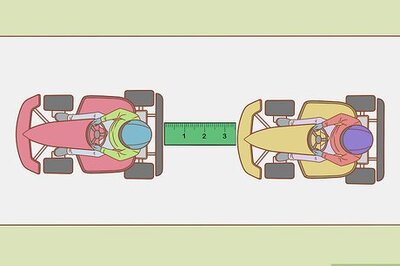
views
New Delhi: After successfully performing the fifth and final orbit manoeuvre to refine its circular path around the moon on Sunday, Chandrayaan 2 lander, 'Vikram', successfully separated from the orbiter on Monday.
The Indian Space Research Organisation (ISRO) confirmed the development in a tweet.
#ISROVikram Lander Successfully separates from #Chandrayaan2 Orbiter today (September 02, 2019) at 1315 hrs IST. For details please visit https://t.co/mSgp79R8YP pic.twitter.com/jP7kIwuZxH— ISRO (@isro) September 2, 2019
“The Vikram Lander successfully separated from Chandrayaan-2 Orbiter at 1315 hours IST today. The Vikram Lander is currently located in an orbit of 119 km x 127 km. The Chandrayaan-2 Orbiter continues to orbit the Moon in its existing orbit,” ISRO said in a statement.
The next maneuver is scheduled for Tuesday between 8:45pm and 9:45pm.
The separation of lander 'Vikram' from Chandrayaan-2 orbiter was scheduled between 12:45 pm and 01:45 pm (IST). Following this, there would be two deorbit manoeuvres of lander 'Vikram' to prepare for its landing in the south polar region of the moon.
Chandrayaan-2 satellite began its journey towards the moon, leaving the earth's orbit in the dark hours, on August 14, after a crucial manoeuvre called Trans Lunar Insertion (TLI) carried out by ISRO to place the spacecraft on "Lunar Transfer Trajectory".
India's Geosynchronous Satellite Launch Vehicle, GSLV MkIII-M1, had successfully launched the 3,840-kg Chandrayaan-2 spacecraft into the earth's orbit on July 22.
“The health of the orbiter and lander is being monitored from the Mission Operations Complex (MOX) at ISRO Telemetry, Tracking and Command Network (ISTRAC) in Bengaluru with support from Indian Deep Space Network (IDSN) antennas at Bylalu, near Bengaluru. All the systems of Chandrayaan-2 Orbiter and Lander are healthy,” ISRO said.
Following the landing, the rover 'Pragyan' will roll out from lander 'Vikram' between 5:30-6:30 am on September 7 an carry out experiments on the lunar surface for a period of one lunar day, which is equal to 14 earth days.
The mission life of the lander is also one lunar day, while the orbiter will continue its mission for a year.
The orbiter carries eight scientific payloads for mapping the lunar surface and study the exosphere (outer atmosphere) of the Moon while the lander carries three scientific payloads to conduct surface and subsurface science experiments.
The rover carries two payloads to enhance the understanding of the lunar surface.
India's second lunar expedition would shed light on a completely unexplored section of the Moon, its South Polar region.
ISRO has said that the mission objective of Chandrayaan-2 is to develop and demonstrate the key technologies for end-to-end lunar mission capability, including soft-landing and roving on the lunar surface.
On the science front, the mission aims to further expand the knowledge about the moon through a detailed study of its topography, mineralogy, surface chemical composition, thermo-physical characteristics and atmosphere, leading to a better understanding of the origin and evolution of the moon, the space agency had said.




















Comments
0 comment